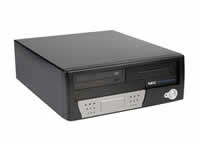NEC Backup Smart Way
NEC Updated: 2008-04-14 RSS
The majority of companies feel the need to backup and protect their data (database, mail, application…). Yet the solutions currently provided by the market do not respond to their exact needs and expectations: they are either too complex to set up and manage, or insufficiently reliable:
* Time spent on backup and data recovery is too time consuming.
36% of companies claim to spend more than 8 hours on backup of data compared to 25% in 2003 (1).
IT teams spend nearly 60% of their time managing backup / data recovery operations. According to 50% of businesses, backup processes are too long (2).
* Backup on remote sites is hard to implement. 75 % of remote sites data are not saved (3).
1: Backup and Archive report, Peripheral Concepts, August 2004
2: Rapport META Group
3: Cabinet Evaluation Group July 2005
An innovating concept
Backup Smart Way has been designed to address these exact issues – making it possible for companies with no on-site dedicated personnel or IT expertise to implement a trustworthy, easy-to-use and efficient backup system. It guarantees that their critical data remains protected while eliminating most of the costly and complicated administration tasks, thus generating a real return on Investment.
Backup Smart Way is an appliance-based solution. This means that it integrates all of the components needed to manage backup & recovery operations. Backup Smart Way’s software and hardware of has been developed in parallel to ensure that they communicate and interact smoothly – a real advantage vs. typical market solutions, in which each component (server, software, tape library) is managed separately and requires external integration and expertise.
Backup Smart Way can be easily and directly installed on the LAN, enabling to backup all the strategic data and applications for Novell, Windows, UNIX and Linux environments. The Backup Smart Way main innovation lies in its backup-to-disk system. The daily backups are first written to the appliance hard disk – a simple operation that makes recoveries available directly from disk - a far more rapid and reliable process compared with recovery from tape.
Data is then mirrored subsequently to a secondary media (Tape or DVD) in order to ensure data integrity in the case of system crash as well as enable companies to keep data off-site.
Download SO,TX50,TX120,TX300 Datasheet
Download SD1000, SD2000, SD3000 Datasheet
Download Case Study [PPT]
Related Manuals
NEC ST1220 Storage
NEC HS Series Grid Storage
NEC D1-10 Storage Array
NEC D3-10 Storage Array
NEC D8-10,20,30,40 Storage Array
NEC S1500 Storage Array
NEC S2500 Storage Array
NEC S2900 Storage Array
HP StorageWorks MSL6000 Tape Libraries
HP StorageWorks MSL8096 Tape Library
HP StorageWorks MSL4048 Tape Library
HP StorageWorks MSL2024 Tape Library